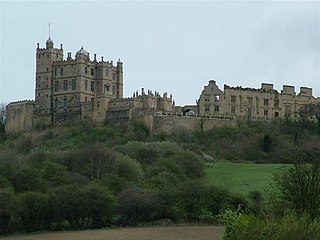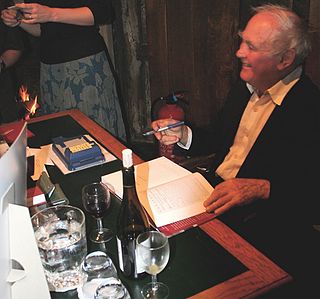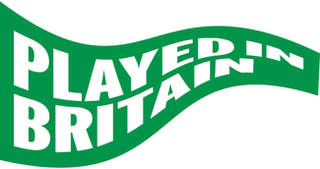
John Arthur Annesley Goodall [1] FSA (born 1970) is an English historian, author, and Architectural Editor of Country Life magazine.

John Arthur Annesley Goodall [1] FSA (born 1970) is an English historian, author, and Architectural Editor of Country Life magazine.
Goodall attended St Edward's House at Ampleforth College until 1988, and then read history at Durham University. He subsequently took both an MA and doctorate as an architectural historian at the Courtauld Institute of Art.
He worked for several years as a freelance writer and scholar, publishing his first book in 2001, God's House at Ewelme, which was joint winner of the Royal Historical Society Whitfield Prize for 2001 (presented in 2002). [2]
He has written several guidebooks for both English Heritage and the National Trust. In addition he has contributed to numerous books and scholarly journals on the subject of historic English architecture. In 2003 Goodall joined English Heritage as a senior properties historian. He acted in 2007 as series consultant for the major BBC 1 series How We Built Britain , presented by David Dimbleby.
From November 2007 Goodall became Architectural Editor of Country Life, a magazine to which he had contributed since 1994. He was involved in a debate over the National Trust's presentation of its houses in 2010, speaking on the subject at the Hay Festival and at the National Trust's AGM.
Goodall's second book, The English Castle, was published by Yale University Press in April 2011 on behalf of the Paul Mellon Centre for Studies in British Art. The work received numerous accolades: the 2011 Alice Davis Hitchcock Medallion, the 2011 Large Format Illustrated Book of the Year Award at the Spear's Book Awards, and the 2013 Historians of British Art Book Prize (pre-1800). [3] The work also received the G. T. Clark Prize for 2007–2012, recognising "the most distinguished published contributions to the study of the history and antiquities of Wales and the Marches during the previous quinquennium". [4]
Other recent projects include contributions to the photographic book The English Cathedral by Peter Marlow [5] and a chapter on the siege of Dover in 1216–17 for the book accompanying the Dan Snow Battle Castle television series. [6] He has acted as series consultant for the Country Life book series taken from the archive of the magazine, including Curious Observations (2011) and Letters to the Editor. [7]
On 25 October 2001, Goodall was elected a Fellow of the Society of Antiquaries of London (FSA). [8] He sits on the Fabric Advisory Committees of St. George's Chapel, Windsor Castle and St Albans Cathedral, and is a part-time Humanities staff member at the City and Guilds of London Art School.
Along with Edward Impey, Goodall is a patron of the Castle Studies Trust, a UK registered charity founded in 2012. [9]

Bolsover Castle is in the town of Bolsover, in the north-east of the English county of Derbyshire. Built in the early 17th century, the present castle lies on the earthworks and ruins of the 12th-century medieval castle; the first structure of the present castle was built between 1612 and 1617 by Sir Charles Cavendish. The site is now in the care of the English Heritage charity, as both a Grade I listed building and a Scheduled Ancient Monument.

Harlech Castle in Harlech, Gwynedd, Wales, is a Grade I listed medieval fortification built onto a rocky knoll close to the Irish Sea. It was built by Edward I during his invasion of Wales between 1282 and 1289 at the relatively modest cost of £8,190. Over the next few centuries, the castle played an important part in several wars, withstanding the siege of Madog ap Llywelyn between 1294 and 1295, but falling to Prince Owain Glyndŵr in 1404. It then became Glyndŵr's residence and military headquarters for the remainder of the uprising until being recaptured by English forces in 1409. During the 15th century Wars of the Roses, Harlech was held by the Lancastrians for seven years, before Yorkist troops forced its surrender in 1468, a siege memorialised in the song "Men of Harlech". Following the outbreak of the English Civil War in 1642, the castle was held by forces loyal to Charles I, holding out until 1647 when it became the last fortification to surrender to the Parliamentary armies. In the 21st century the ruined castle is managed by Cadw, the Welsh Government's historic environment service, as a tourist attraction.

A battlement, in defensive architecture, such as that of city walls or castles, comprises a parapet, in which gaps or indentations, which are often rectangular, occur at intervals to allow for the launch of arrows or other projectiles from within the defences. These gaps are termed embrasures, also known as crenels or crenelles, and a wall or building with them is described as crenellated; alternative older terms are castellated and embattled. The act of adding crenels to a previously unbroken parapet is termed crenellation.

Palladian architecture is a European architectural style derived from the work of the Venetian architect Andrea Palladio (1508–1580). What is today recognised as Palladian architecture evolved from his concepts of symmetry, perspective and the principles of formal classical architecture from ancient Greek and Roman traditions. In the 17th and 18th centuries, Palladio's interpretation of this classical architecture developed into the style known as Palladianism.

John Martin Robinson FSA is a British architectural historian and officer of arms.

Bowes Castle is a medieval castle in the village of Bowes in County Durham, England. Built within the perimeter of the former Roman fort of Lavatrae, on the Roman road that is now the A66, the early timber castle on the site was replaced by a more substantial stone structure between 1170 and 1174 on the orders of Henry II. A planned village was built alongside the castle. Bowes Castle withstood Scottish attack during the Great Revolt of 1173–74 but was successfully looted by rebels in 1322. The castle went into decline and was largely dismantled after the English Civil War. The ruins are now owned by English Heritage and managed as a tourist attraction. There is free admission during daylight hours.
In medieval England, Wales and the Channel Islands a licence to crenellate granted the holder permission to fortify his property. Such licences were granted by the king, and by the rulers of the counties palatine within their jurisdictions, i.e. by the Bishops of Durham, the Earls of Chester, and after 1351 by the Dukes of Lancaster.

Hornby Village Institute is a public building in Main Street, Hornby, Lancashire, England. It is considered to be important architecturally, and is recorded in the National Heritage List for England as a designated Grade II listed building.

Adrian John Tinniswood FSA is an English writer and historian. He is currently Professor of English Social History at the University of Buckingham.

John Frederick Harris OBE was an English curator, historian of architecture, gardens and architectural drawings, and the author of more than 25 books and catalogues, and 200 articles. He was a Fellow and Curator Emeritus of the Drawings Collection of the Royal Institute of British Architects, founding Trustee of Save Britain's Heritage and Save Europe's Heritage, and founding member and Honorary Life President of the International Confederation of Architectural Museums.

Played in Britain is a ten-year research project for English Heritage which seeks to record and celebrate Britain's sporting and recreational heritage, coinciding with the period from the staging of the 2002 Commonwealth Games in Manchester to the 2012 Olympics. Much of the research has been made publicly available in a series of books, also called Played in Britain, featuring historic buildings and sportscapes. The series also looks at sporting artefacts and archaeology.

Mark Girouard was a British architectural historian. He was an authority on the country house, and Elizabethan and Victorian architecture.
Giles Arthington Worsley was an English architectural historian, author, editor, journalist and critic, specialising in British country houses. He was the second son of Sir Marcus Worsley, 5th Baronet, of Hovingham Hall, a nephew of Katharine, Duchess of Kent, and died of cancer aged 44.
Warwick James Rodwell is an archaeologist, architectural historian and academic. He was lately Visiting Professor in the Department of Archaeology, University of Reading, and is Consultant Archaeologist to Westminster Abbey, where he is also a member of the College of St Peter in Westminster. He is the author of many books and articles, including the standard textbook on church archaeology. He is a Fellow of the Society of Antiquaries of London, the Society of Antiquaries of Scotland and the Royal Historical Society.
James Stevens Curl is an architectural historian, architect, and author with an extensive range of publications to his name.

Peveril Castle is a ruined 11th-century castle overlooking the village of Castleton in the English county of Derbyshire. It was the main settlement of the feudal barony of William Peverel, known as the Honour of Peverel, and was founded some time between the Norman Conquest of 1066 and its first recorded mention in the Domesday Survey of 1086, by Peverel, who held lands in Nottinghamshire and Derbyshire as a tenant-in-chief of the king. The town became the economic centre of the barony. The castle has views across the Hope Valley and Cave Dale.

Warkworth Castle is a ruined medieval castle in Warkworth in the English county of Northumberland. The village and castle occupy a loop of the River Coquet, less than a mile from England's north-east coast. When the castle was founded is uncertain: traditionally its construction has been ascribed to Prince Henry of Scotland, Earl of Northumbria, in the mid-12th century, but it may have been built by King Henry II of England when he took control of England's northern counties. Warkworth Castle was first documented in a charter of 1157–1164 when Henry II granted it to Roger fitz Richard. The timber castle was considered "feeble", and was left undefended when the Scots invaded in 1173.
Charles McKean FRSE FRSA FRHistS FRIBA was a Scottish historian, author and scholar.
John Lewley Cornforth CBE was an architectural historian with a particular interest in the history of English country houses. He was the author of many books and articles, and architectural editor of Country Life from 1967 to 1977.
Francis P. Kelly is a British architectural historian and formerly an inspector for English Heritage and Historic England, working in the south west of England. He has contributed to a number of publications on medieval buildings, and his extensive slide collection is held by Historic England. He is a member of the British Archaeological Association.